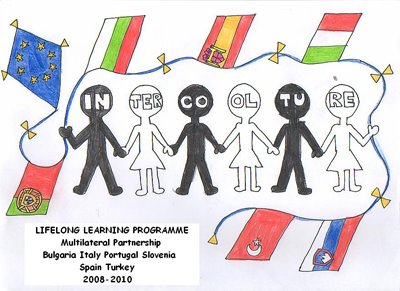
The motto of our town is “Vratsa – a town like the Balkan – ancient and young.” The monument of the Herald – a Russian soldier, who playing a bugle announced the liberation of our town. The poet revolutionary Hristo Botev was killed at the peak of Okolchitsa, near out town. The Meschii tower in the central town square is a medieval tower which dates back from the 16th century. There is an ethnographic and revival period complex in the town. It is named after St. Sofronii Vrachanski, the patron of our school. The House of tourists built in 1926 with the voluntary work of tourists from Vratsa is on a hill above our town.
The old Bulgarian capitals Pliska, Preslav, Veliko Tarnovo are connected with our history. They keep the memory of past distant times and memorable events. There are monuments erected in the towns of Pleven and at Shipka peak connected with the Russian-Turkish war of liberation.
Bulgaria is a piece of heaven. Our country is more that 1300 years old. It has rich past and cultural heritage. We are proud of having unique nature – high mountains, cool forests, crystal clear lakes, mineral springs, lovely Black sea, attractive to us and the foreigners resorts, monasteries, natural formations. Our people are hard-working and hospitable.
We love our customs, the traditional holidays, the folk dances and songs, the legends, connected with historical and geographical places of interest.
The most traditional songs for Bulgaria are the folk songs. Our country is divided into seven folklore districts and each has its specific songs. The region of Vratsa belongs to the Northern folklore district. Our songs are characterized with unequal rhythms and impress the music fans all over the world. A Bulgarian song is recorded and sent to space with the spaceship Voyager in the 1970s.
Our traditions are mostly connected to the Christian faith – for Easter we colour eggs, on St. Nikola’s day we eat fish, and on Chritmas – we eat banitsa (pastry with cheese and eggs) with lucky charms. We also celebrate Sty. Lazar’s day when little lasses dance in the house yards for health and fertility. We make survachki (as the ones we sent you) for patting our backs for health on the New Year’s Day. Our mummers (kukeri) dances are very interesting too. They are danced by young men who wear mask to scare away evil.
Our folklore garments consist of a long white gown with embroidered sleeves, typical trousers for the men (poturi), waistcoat, red wide textile belt, and a fur hat (kalpak); for the women – skirt ot sleeveless dress, apron, peabold stockings, kerchief and flowers for the head. People used to put on pig skin shoes. The typical colours of the folklore garment are red, white, blue, black and green
We eat various foods in our country but we, the children mostly like chips, banitsa, soup, beans, pizza, spaghetti, doner, baklava, cakes although we know that vegetables, fruit and dairy products are best and healthiest for us. We have typical dishes eaten on traditional holidays. They are vegetarian stuffer peppers and cabbage leaves on Christmas eve, kapama and sore cabbage dishes for the New Year’s Eve, fish for St. Nikola’s day, banitsa and halva on the first Sunday before Lent, kozunak for Easter, lamb meat for St. Georgi’s day.
The typical foods we eat are banitsa, soup, musaka, beans, lentils, peas, hand-made bread with cheese, kosunak (sweet Easter bread with raisins).
Our school has a 100-year history. There are children from 1st to 4th grade to study in it. It has two floors and large light rooms. We have a music and arts studies, two computer rooms and a gym.
We start studying English from the 2nd grade – at the beginning twice a week, and in 3rd and 4th grade – three times a week.
All the children at the school study English, a child attends Spanish language training; there are children with little knowledge of Italian and German.
We are not taught musical instruments and we don’t play any at school. We have a classmate who studies the Bulgarian folk instrument kaval. We have facultative study of maths, athletics, art, choir, folk dances. Our compulsory subjects are – Bulgarian language and literature, maths, man and society, man and nature, music, art, English, sports and technology.
Sometimes our curriculum is easy, sometimes difficult. We have five or six lessons a day.
We start our compulsory education at the age of 6 with a preparatory class and then start school at 7. Primary education includes 1-4 grades, secondary – 5-8 and high school is afterwards until 12th grade. Then the good and ambitious adolescents study at universities and pass hard exams.


